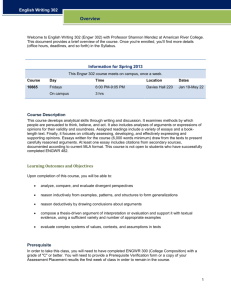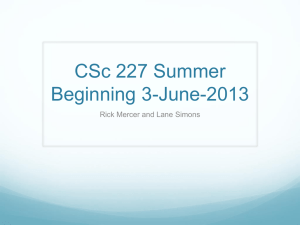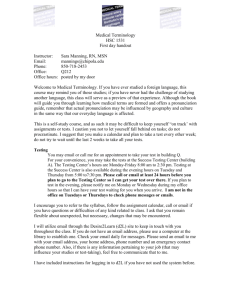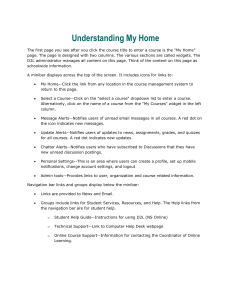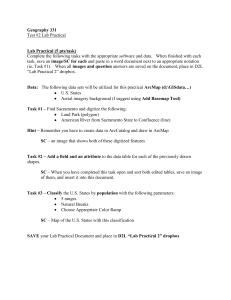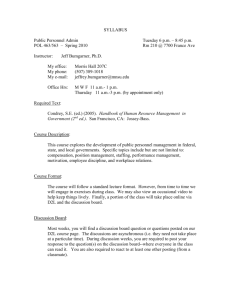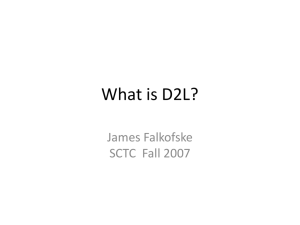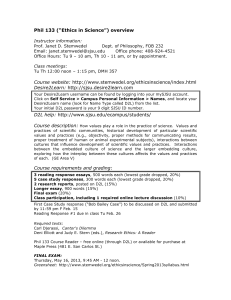Word
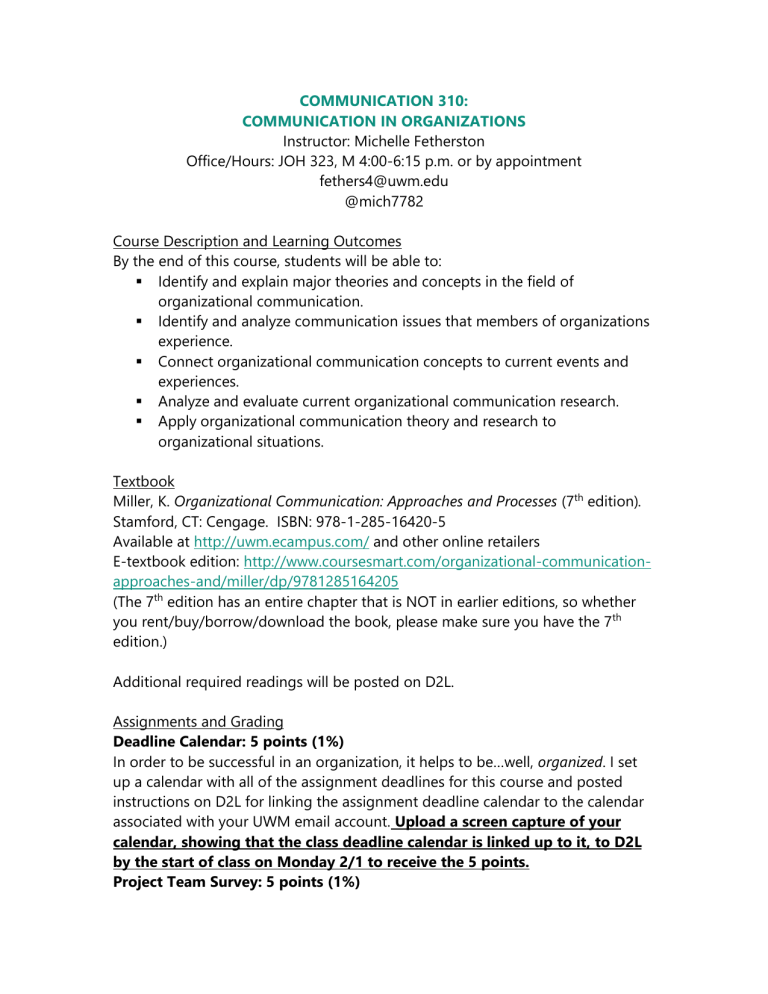
COMMUNICATION 310:
COMMUNICATION IN ORGANIZATIONS
Instructor: Michelle Fetherston
Office/Hours: JOH 323, M 4:00-6:15 p.m. or by appointment fethers4@uwm.edu
@mich7782
Course Description and Learning Outcomes
By the end of this course, students will be able to:
Identify and explain major theories and concepts in the field of organizational communication.
Identify and analyze communication issues that members of organizations experience.
Connect organizational communication concepts to current events and experiences.
Analyze and evaluate current organizational communication research.
Apply organizational communication theory and research to organizational situations.
Textbook
Miller, K. Organizational Communication: Approaches and Processes (7 th edition).
Stamford, CT: Cengage. ISBN: 978-1-285-16420-5
Available at http://uwm.ecampus.com/ and other online retailers
E-textbook edition: http://www.coursesmart.com/organizational-communicationapproaches-and/miller/dp/9781285164205
(The 7 th edition has an entire chapter that is NOT in earlier editions, so whether you rent/buy/borrow/download the book, please make sure you have the 7 th edition.)
Additional required readings will be posted on D2L.
Assignments and Grading
Deadline Calendar: 5 points (1%)
In order to be successful in an organization, it helps to be…well, organized. I set up a calendar with all of the assignment deadlines for this course and posted instructions on D2L for linking the assignment deadline calendar to the calendar associated with your UWM email account. Upload a screen capture of your calendar, showing that the class deadline calendar is linked up to it, to D2L by the start of class on Monday 2/1 to receive the 5 points.
Project Team Survey: 5 points (1%)
This course involves a semester-long group project, so I developed a short survey regarding past roles, experiences, etc. on group projects in order to assign students to project teams. Complete the survey on D2L by the start of class on
Monday 2/1 to receive the 5 points.
Individual Topic Presentation: 50 points (10%)
Each student will choose a course topic to connect to a specific organization via a brief write-up and in-class presentation. A separate assignment instruction sheet with more detailed information and grading criteria for this project is posted on
D2L.
Journal Article Analysis: 100 points (20%)
You will each read an organizational communication scholarly journal article of your choosing and write an analysis of the article, using course concepts to support your arguments. A separate assignment instruction sheet with more detailed information and grading criteria for this project is posted on D2L.
Intro to Organizational Communication Project: 150 points (30%)
You will form “mini-organizations” of 4-5 students and will work together over the course of the semester to create a deliverable that introduces organizational communication to next semester’s class. Of the 150 points, 125 will be a team score (same score to each team member) and the remaining 25 points will be earned individually based on teammate evaluations. A separate assignment instruction sheet with more detailed information and grading criteria for this project is posted on D2L.
Intro to Organizational Communication Project Individual Final Report: 75 points (15%)
As you work with your “mini-organization” this semester, you will want to keep some notes on your interactions, because at the end of the semester you’ll write a final report assessing specific course concepts experienced during your interactions with your teammates. A separate assignment instruction sheet with more detailed information and grading criteria is posted on D2L.
Attendance and Participation: 90 points (18%)
I award 3.5 points per class period* for attendance and participation. I typically incorporate a variety of activities into class sessions, including independent reflections and small group discussions, so students who may not feel comfortable speaking up in front of the whole class can still easily earn these points. However, it’s not possible to earn these points if you are asleep, not
paying attention, or not in class. If you do miss class, it is your responsibility to check with a classmate about what you missed, as I will not respond to emails from students who were absent and ask “what they missed”.
*This includes your team’s individual project status meetings as noted on the class schedule at the end of the syllabus. The points breakdown allows for two absences before points are lost in this category.
Grading Summary
Calendar and Project Team Survey:
Individual Topic Presentation
Journal Article Analysis:
Intro to Organizational Communication Project – Team Score 125
Intro to Org. Comm. Project – Individual Score
Intro to Org Comm Project Individual Final Report
Attendance and Participation:
Total Points Possible:
25
10
75
100
75
90
500
Grading scale:
A 94 – 100%
A- 90 – 93.9%
B+ 87 – 89.9%
B 84 – 86.9%
B- 80 – 83.9%
C+
C
77 – 79.9%
74 – 76.9%
C- 70 – 73.9%
D+ 67 – 69.9%
D 64 – 66.9%
D-
F
60 – 63.9%
< 60%
Policies and Guidelines
Document Guidelines
Unless otherwise noted in assignment instructions, all written assignments must be submitted to D2L in Microsoft Word (.doc/.docx) or PDF format. All written work should be typed and formatted using APA style (Times New Roman or Arial
12 point font, 1 inch margins and properly formatted title and reference pages).
We will go over APA formatting in class, but be sure to use the Writing Center on campus and/or appropriate online resources if you need additional help.
Late Work
Assignments are due to the D2L dropbox by the start of class (11:00 a.m.). If you do miss a deadline, you may receive partial credit as follow unless specified otherwise in individual assignment guidelines:
< 7 days late: points reduced by 25%
7 – 10 days late: points reduced by 50%
11 – 14 days late: points reduced by 75%
> 14 days late: automatic 0 o Note: for assignments due the last two weeks of the semester, anything not submitted by 5/15 is an automatic 0
The D2L dropboxes will automatically flag late assignments through the end of the “grace period”, so you can still upload an assignment to the appropriate dropbox if it’s late. Please do not email me the assignments (and definitely don’t email me the excuses why the work is late!) There are no exceptions to this policy , so plan ahead and manage your time accordingly.
Technology Use
I have set up a course web page in D2L, which will contain important course information and supplemental readings, as well as dropboxes for each assignment. Check it regularly, as you are responsible for all information that is posted on D2L. You can access D2L at: http://d2l.uwm.edu
.
If I need to notify you of something outside of class time, I will send the information via campus email. (Translation: check your email regularly!)
As you get out into the working world, you’ll discover it’s incredibly annoying to be in meetings with people who are constantly distracted by other things on their phones. I find this equally true in the classroom, so make sure your phones, laptops, tablets, etc. are silenced and put away unless we’re using them for a class activity. You will lose points from the attendance and participation portion of your grade when violating this policy (and quite honestly, if class is that boring,
I’d rather we fix it.)
Students with Disabilities
If you believe you might need accommodations to meet any of the requirements of this course, please contact the Accessibility Resource Center (ARC) in Mitchell
Hall. I will work with you and the ARC to make whatever accommodations are needed, but the ARC should be involved because of their knowledge and experience in this area.
Religious Observances and Military Service:
Notify me as soon as possible if a religious observance or military obligations conflicts with class and/or assignments so we can make arrangements.
Academic Misconduct:
UWM takes academic misconduct very seriously. Cheating or plagiarism are violations of the academic honor code and carry severe sanctions, including failing a course or even suspension or dismissal from the University. Any evidence of cheating, plagiarism, or misrepresentation of work will result in an automatic failing grade on the exam or assignment. Evidence of academic misconduct will also be immediately reported to the College of Letters and Science for disciplinary action. Please see University guidelines for further explanation of academic misconduct and disciplinary procedures.
Discriminatory Conduct (such as sexual harassment)
I do NOT tolerate discriminatory conduct of any kind, nor does the University. If we treat everyone in our class with respect, this will be a non-issue.
Complaint Procedures
If you have complaints about any part of the course, please contact me. If we are unable to resolve the issue, we will take the concern to the course director and, if necessary, the department chair.
Grade Appeal Procedures
If you wish to discuss or appeal a grade, please contact me. In the event that you are unable to resolve your appeal at that level, please note that a student may appeal a grade on the grounds that it is based on a capricious or arbitrary decision of the course instructor. Such an appeal shall follow the established procedures adopted by the Department of Communication, Colleges of Letters and Science, or UWM.
Syllabus Changes
If anything should change regarding the syllabus, readings, or assignments, I will inform you well in advance by announcing it in class and/or posting information on D2L. Assignment deadlines will never be moved up earlier than what is listed on the syllabus.
Other Policies
This course will comply with policies and procedures designated by the
Department of Communication, the College of Letters and Science, and the
University. Additional policies are available on the bulletin board outside the administrative offices of the Department of Communication. University policies can be found at: http://www4.uwm.edu/secu/news_events/upload/Syllabus-
Links.pdf
Schedule At a Glance
Date Readings/Assignments Due
Week 1: Course Intro/The Changing Landscape of Organizations
Monday 1/25
Wednesday 1/27
Syllabus/course overview
Skim through Textbook chapters 1 and 14
Week 2: Finish Changing Landscape of Organizations; Classical and Human Relations
Approaches
Monday 2/1 Course deadline calendar and team member survey due in
D2L by 11:00 a.m.
Berkelaar reading (D2L)
Wednesday 2/3 Textbook chapters 2 and 3; Kovensky and Semuels readings (D2L)
Week 3: Decision-Making Processes
Monday 2/8
Wednesday 2/10
Textbook chapter 8
Student Topic Presentations
Week 4: Systems and Cultural Approaches
Monday 2/15
Wednesday 2/17
Textbook chapter 4
Laloux reading (D2L); Student Topic Presentations
Week 5: Constitutive and Critical Approaches
Monday 2/22
Wednesday 2/24
Textbook chapters 5 and 6
Student Topic Presentations
Week 6: Begin Socialization
Monday 2/29
Wednesday 3/2
Journal Article for Analysis Paper due to D2L by 11:00 a.m.
NO CLASS – use time to meet with project teams
Textbook chapter 7
Week 7: Finish Socialization; First project sprint review
Monday 3/7
Wednesday 3/9
Jahn & Myers reading (D2L); Student Topic Presentations
Intro to Org Comm. Project Proposals due in D2L by 11:00
a.m.
Individual Intro to Org. Comm. Project Team Meetings
Monday 3/14 &
Wednesday 3/16
SPRING BREAK – NO CLASS
Week 8: Identity; Begin Conflict
Monday 3/21 Journal Article Analysis Paper due in D2L by 11:00 a.m.
Eisenberg, Goodall & Trethewey reading (D2L)
Schedule At a Glance (cont’d.)
Wednesday 3/23 Textbook chapter 9
Student Topic Presentations
Week 9: Finish Conflict; Project Sprint Reviews
Monday 3/28
Wednesday 3/30
Week 10: Organizational Change & Leadership
Monday 4/4 Textbook chapter 10
Wednesday 4/6 Lippman and Bersin readings (D2L)
Student Topic Presentations
Week 11: Emotion in the Workplace
Monday 4/11
Wednesday 4/13
Week 12: Technology
Monday 4/18
Wednesday 4/20
Peterson reading (D2L); Student Topic Presentations
Intro to Org Comm. Initial Project Drafts due by 11:00 a.m.
Individual Intro to Org. Comm. Project Team Meetings
Textbook chapter 11
Kramer & Hess reading (D2L); Student Topic Presentations
Textbook chapter 13
Intro to Org Comm. Complete Project Drafts due by 11:00 a.m.
Individual Intro to Org. Comm. Project Team Meetings
Week 13: Finish Technology; Start Diversity
Monday 4/25 Student Topic Presentations
Wednesday 4/27 Textbook chapter 12; Manjoo reading (D2L)
Week 14: Finish Diversity; Final review
Monday 5/2 Student Topic Presentations
Wednesday 5/4 Review/final presentation and paper Q&A
Week 15: Projects and Report
Monday 5/9 Intro to Org. Comm. Final Projects due by 11:00 a.m.;
Intro to Org. Comm. Final Project Presentations in class
Intro to Org. Comm. Project Teammate Evaluations due in
D2L by 11:59 p.m.
Sunday 5/15 Intro to Org. Comm. Individual Project Assessment Report due on D2L by 11:59 p.m.
Course Hour Time Investment Distribution
These are estimates and will vary by individual student:
Classroom: 40 hours Preparation for class (readings, etc.): 40 hours
Completing assignments: 64 hours Total: 144 hours
Appendix: References for D2L Readings
Berkelaar, B. L. (2014). Cybervetting, online information, and personnel selection:
New transparency expectations and the emergence of a digital social contract.
Management Communication Quarterly, 28(4), 479-506. doi:
10.1177/0893318914541966
Bersin, J. (2013). Millennials will soon rule the world: But how will they lead?
Retrieved from http://www.forbes.com/sites/joshbersin/2013/09/12/millenialswill-soon-rule-the-world-but-how-will-they-lead/
Eisenberg, E. M., Goodall, Jr., H. L., & Trethewey, A. (2013). Organizational
Communication: Balancing Creativity and Constraint. Boston, MA: Bedford-St.
Martin’s.
Jahn, J. L. S., & Myers, K. K. (2015). “When will I use this?” How math and science classes communicate impressions of STEM careers: Implications for vocational anticipatory socialization. Communication Studies. Advance online publication. doi:10.1080/10510974.2014.990047
Kovensky, J. (2014). Chief Happiness Officer is the latest, creepiest job in corporate America. Retrieved from http://www.newrepublic.com/article/118804/happiness-officers-are-spreadingacross-america-why-its-bad
Kramer, M. W., & Hess, J. A. (2002). Communication rules for the display of emotions in organizational settings. Management Communication Quarterly,
16(1), 66-80.
Laloux, F. (2014). Reinventing organizations: A guide to creating organizations
inspired by the next stage of human consciousness. Brussels, Belgium: Nelson
Parker.
(note: we are only reading exceprts from this book)
Lipman, V. (2014). Survey shows employees’ main New Year’s wish is better communication. Retrieved from http://www.forbes.com/sites/victorlipman/2014/12/21/survey-shows-employeesmain-new-years-wish-is-better-communication/
Manjoo, F. (2014). Exposing hidden bias at Google. Retreived from http://www.nytimes.com/2014/09/25/technology/exposing-hidden-biases-atgoogle-to-improve-diversity.html?_r=
Peterson, D. (2014). Lindred Greer: Why virtual teams have more conflict.
Retreived from http://www.gsb.stanford.edu/insights/lindred-greer-why-virtualteams-have-moreconflict?utm_content=buffere969c&utm_medium=social&utm_source=twitter.co
m&utm_campaign=buffer
Semuels, A. (2014). A new business strategy: Treating employees well. Retrieved from http://www.theatlantic.com/business/archive/2014/11/a-new-businessstrategy-treating-employees-well/383192/
